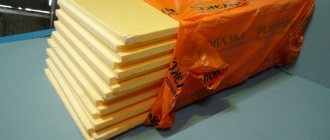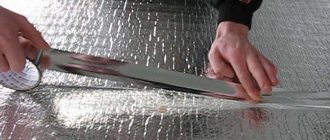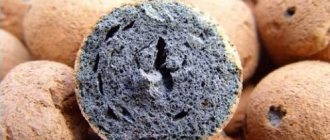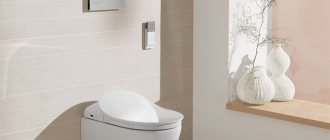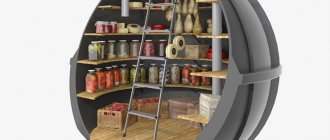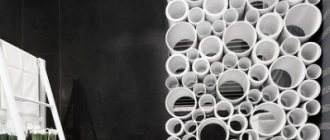Before laying a floating floor, knowledgeable customers periodically ask me whether it is necessary to lay film under the laminate. Here we can clarify that the film is placed under the substrate.
The technical instructions contained in the package with laminated parquet indicate: “To ensure warranty service, it is necessary to lay a vapor barrier with a thickness of 0.2 mm or 200 microns.”
Let's try to figure out why moisture-proof polyethylene is needed and how well it works. In Leroy
Edit 2021
I must note. In the last year of observations, the PVC vapor barrier film under the laminate has a strong unpleasant odor. Which completely negates the idea of using it with materials such as parquet boards or cork. Positioned by sellers as the pinnacle of environmental cleanliness.
The second point, which I had not previously mentioned, is that the spread film forms air pockets due to the folds. And when you further lay the backing on top of the film, the backing does not completely adhere to the base. Sounds may occur after laminate flooring is installed. Of course, the air will subsequently escape and the laminate will settle down. But I had to give extra explanations.
Before a long story, I want to notify readers that most types of laminate have their own protection from moisture penetration underneath. It consists of a bottom layer consisting of melamine resin or kraft paper, which is moisture-resistant, and covers more than 99% of the surface of the plank. The chance of panel joints getting into a substrate seam tends to zero, and the possible contact area of unprotected parts is 0.0000...
A little about laminate
This type of flooring material is one of the most popular. It perfectly imitates expensive wooden floors, but at the same time it is relatively inexpensive, for which it is appreciated. You can now see this material in almost any home. Its installation is simple, but when laying it is important to follow a number of rules that will extend the life of the floors for as long as possible.
The laminate itself consists of fairly large (up to 1.5 m long and about 15-20 cm wide) planks called lamellas. But the thickness of each board may vary depending on the class of coating. So, it varies between 6-12 mm.
On a note! There are several classes of laminate, which are marked with numbers from 21 to 33. Depending on the density and strength, the material can be used for arranging floors in any premises, except perhaps industrial ones.
Each lamella is a multilayer element consisting of 4 layers:
- protective top , which can protect the coating from moisture;
- decorative , usually made of paper with a pattern printed on it that can imitate wood, stone and other types of floor coverings;
- main , which is made of fiberboard or chipboard and is load-bearing. It is this layer that ensures the strength of the coating, but at the same time is resistant to moisture;
- lower protective , which protects the material from the effects of negative factors from below.
Attention! Laminate is afraid of water - the main supporting layer can easily be damaged if the material gets seriously wet. That is why it is important to protect it at all costs from moisture.
During installation of the coating, the individual lamellas are fastened together thanks to a special locking system. This results in a smooth and monolithic coating. In some cases, an adhesive composition can be used during installation - then the base will be very strong, but it will not be possible to dismantle it without damaging the slats.
Laying laminate flooring is simple, and even a novice master can handle this task. However, it is important to follow a number of rules so that the material fits well and lasts a long time. Hydro- and vapor barrier deserve special attention.
Laminate structure
Laminate flooring consists of individual panels up to 1.5 meters long and 15-20 cm wide. The thickness of the laminate can vary depending on the type of room where it will be installed, and range from 6 to 12 mm. Laminate flooring is usually divided into service classes from 21 to 33. It is used in almost any room: from the bedroom to a restaurant or gym.
Laminate is attached in two ways: locking or using glue. Currently, the first option is predominantly used. There are tongues and grooves on the end sides of the panels, thanks to which the laid laminated coating looks smooth and monolithic. If you install the floor using glue, then the advantage of this method will be a strong fastening.
Laminate most often consists of 4 layers:
- The top protective layer is made of resin, which protects the floor from abrasion, the harmful effects of sunlight, and the penetration of dust and moisture into the structure.
- The decorative layer is represented by paper with an image of wood texture printed on it. If the top layer is damaged, the decorative part may receive significant damage, and the laminate itself may become unsuitable for further use.
- The main layer of laminate flooring is made of fiberboard or chipboard that has undergone high-temperature, high-pressure treatment. It has high strength and moisture resistance, but if moisture gets in from the end parts of the panels, it is likely to deteriorate, rendering the entire floor covering unusable.
- The bottom layer of the laminate is paper impregnated with resin. The bottom layer ensures the leveling of each laid panel and protection from moisture from the base of the floor. Due to the limited capabilities of this layer, additional degrees of protection for the subfloor are required.
To prepare for laying laminated flooring, steam and waterproofing of the subfloor is used.
About waterproofing under laminate
Since laminate is afraid of water, you definitely need to worry about waterproofing when laying it. Most craftsmen tend to lay a layer of plastic film under the coating, which will play a waterproofing role. But in general, waterproofing can be done in a different format.
Waterproofing laminate flooring is very important
Table. Types of waterproofing.
| Type of waterproofing | Description |
| Roll | In this case, various roll materials are used to create a waterproofing layer. They can be either polymer or bitumen-based. Usually it is enough to simply glue the pieces of the required size onto the base using glue, make sure that there are no unclosed seams, and the waterproofing is ready. It is recommended to add materials to the walls by approximately 15-20 cm. In this case, only the adhesive layer needs to be dried before starting further work. |
| Concrete | This type of waterproofing is prepared from cement and sand, sometimes with the addition of liquid glass. You should coat the base with this mixture, without missing a single centimeter of the surface, and also partially apply a layer of waterproofing to the walls (15-20 cm). It is best to apply in several layers, after which it is important to dry the surface thoroughly. |
| In this case, liquid bitumen or polymer compositions are used, which are applied to the base and lower parts of the walls. After the mixtures harden, a reliable protective layer is formed that will not allow moisture to pass through. |
How is waterproofing done?
For a laminated coating, waterproofing under the laminate is a mandatory component. Humidity has a detrimental effect on materials and also causes mold to form.
To prevent this, when laying laminate, one of the following types of waterproofing is used:
- Concrete. Prepared from sand and cement in proportions 2:1. If possible, liquid glass is added to the solution. The mixture is laid on the base of the floor, extending onto the sides of the walls - up to 15-20 cm. The base must be cleaned of dust and dirt. Apply at least 4 layers with breaks between each installation of 15 minutes. The last layer is left to dry for 2-3 days; if possible, the surface is moistened, protecting it from the formation of cracks.
This is what concrete waterproofing looks like
- Rolled. Roll materials are used - polymer and bitumen-polymer. The waterproofing is attached to the base of the floor with the adhesive side. The base is first cleaned and covered with mastic. Waterproofing tapes, 1.5 mm thick, are applied with an overlap of at least 10 cm.
Roll waterproofing
- The cast method is highly reliable and is used even for insulating heated floors , which are subject to the most stringent requirements. Bitumen mixture or polymers are used. The solution is heated and applied to the base of the floor, and then leveled with a spatula. For reliable waterproofing, several layers of the mixture are required.
What is cast waterproofing?
An additional waterproofing effect is added using a film. The film must be at least 50 microns wide, optimally 0.2 mm. The floor is covered entirely; if the width of the film is not enough, then it is applied with an overlap of up to 20 cm. The film spreads, extending onto the walls. After installing the plinth, excess film is removed. Then the underlayment is laid on the base of the floor.
Film for waterproofing under laminate
Types of substrates
Substrates are divided into three types:
- The polyethylene foam backing is made of polyethylene foam and contains a moisture-resistant membrane. A film with such a backing is not needed.
- The polystyrene backing is made in two versions: the more modern one - with a moisture-resistant layer, the traditional one - without it. Based on this, the film is either used or not.
- The cork substrate is made without waterproofing; it is necessary to use a film with it.
Laying of laminated floors is carried out in the sequence: film - substrate - laminated coating.
Why lay film under laminate?
The need to use a vapor barrier film for flooring under laminate is due to the fact that this decorative material is made of wood fiber raw materials. All installation instructions contain instructions for additional protection of the floors from moisture from below.
Moisture not only destroys the material and can cause it to warp, but also contributes to the spread of mold and unpleasant odors. To prevent this from happening, a film should be placed when installing the laminate.
If the panels swell due to moisture, the manufacturer has the right to cancel the warranty because proper lower water protection was not provided
Substrate functions
To protect against these harmful factors, underlay material is used. And here are the functions it performs.
- Leveling the base. There is debate about this function of the substrate on the Internet. Some claim that the substrate is not capable of hiding the unevenness of the base, while others claim that the substrate at least somewhat protects against defective areas of the concrete screed. It is worth noting that the substrate is an elastic material that follows the contours of the base, and the ability to protect against unevenness depends on the size of those very flaws in the preparatory work. If the concrete base is too uneven and has differences of more than 3 mm per square meter, then it is wrong to think that the substrate will solve everything.
- Knock protection. But the substrate can perform the following function well. Its shock-absorbing qualities are good, but the duration of this ability is short. Over time, the substrate will become greatly deformed and compacted, which will greatly deteriorate the quality of this layer.
- Moisture protection. Here everything directly depends on the type of material. Some representatives are good protectors from moisture, some easily let it through, and in such cases additional waterproofing is needed.
This is what moisture can do.
The protective functions of the substrate from the harmful trinity directly depend on the type of material. Even in the best case, if the underlay has waterproofing properties, it may not be well cushioned. And here you need to decide in whose favor to make a choice, besides, other indicators, for example, environmental friendliness, will be factors in the choice.
In addition to the above functions, the substrate performs a couple more of the following:
- thermal insulation. It protects the room from heat loss. The thermal insulation properties of the material are in demand because the laminate itself is a cold material, and the backing, even if only a little, will be able to retain heat and make the coating pleasant and cozy for the feet;
- soundproofing. Noise from children and vibrations from operating household appliances can cause a lot of headaches for neighbors. Therefore, the substrate is able to prevent the penetration of noise and dampen vibrations. This property also works in the opposite direction.
These two properties of the substrate material become selection factors that are not the first choice.
Rules for applying rubber paint "AKTERM HydroStop"
Before applying mastic, it is important to make sure that the surface is dry, not prone to capillary rise of moisture, and has no traces of paint coatings, oils, grease and other substances that impede the quality adhesion of the waterproofing coating to the base.
Rubber paint must be applied at a temperature of no less than +7 °C and no more than +45 °C, the layer thickness should not exceed 1 mm, the consumption in this case is 1.15 kg per square meter. The drying time of the applied layer is 24-48 hours at t>+15°C, after which it is possible to apply the next layer of waterproofing crosswise in relation to the previous one.
The optimal thickness of the waterproofing layer is 2 mm. A correctly applied waterproofing layer is uniform, dense, without sagging. After the mastic has dried, you can install the heated floor, if planned, and lay the finishing floor covering.
Characteristics of protective film
- Protection from water and dirt . The sticker protects parquet and laminate flooring from water and dirt.
- Easy to stick and remove . The protective sticker does not leave traces of glue on the floor. It is easy to install and remove.
- Scratch protection . Protects parquet and laminate flooring from scratches when using a chair on wheels.
- Does not interfere with cleaning . The protective sticker sticks firmly to the floor and becomes invisible.
Clean, shiny floors are the basis for the comfort and beauty of your home. But nothing spoils a pleasant impression more than scratches and dirt. You can, of course, try to cover up the damage with carpets (which do not always fit into the interior and cause a lot of trouble with cleaning), or, what is even more difficult and expensive, replace the covering. But it’s much easier to avoid such problems in the first place. And now it is very easy to do this. It is to prevent scratches, dirt and any mechanical damage that a unique protective sticker was invented. You no longer have to worry about your heels scratching the parquet floor or your beloved cat deciding to sharpen its claws. Scratches from a chair on wheels or damage from rearranging furniture are no longer a concern - your floor will always be perfect thanks to the protective sticker.
The sticker not only prevents a variety of damage, but also protects against the effects of dirt, water and sand. The protective sticker makes cleaning the room much easier. No need to waste time on repairs - just replace the film, and your floor will be sparkling clean again. The decals are great for use in the area you need, whether it's a kitchen countertop, a pet feeding area, a rolling chair area, or an area near the front door. Another advantage of protective stickers is their simplicity and ease of use. They are easy to replace and suitable for parquet and laminate flooring. After removing the film, no traces remain on the surface.
Types of films for laminate, prices
Additional waterproofing is not a requirement when installing laminate flooring. Its feasibility increases significantly when the room is characterized by high humidity. In other cases, the film material is laid as necessary.
Among the variety of means for ensuring high-quality waterproofing, 3 commonly used types should be distinguished:
- Perforated polyethylene film (or, for example, regular film). It is rarely used, since such a vapor barrier tends to create greenhouse conditions that are unacceptable for a floor structure, since they provoke the appearance of unnecessary condensation that cannot be removed.
- Reinforced two-layer film (rigid mesh between layers of polyethylene).
- Vapor barrier membranes that allow you to maintain an optimal indoor microclimate.
It is worth noting that vapor barrier extends the service life of the insulation, as it prevents condensation from penetrating into it.
As for prices, they mainly depend on the supplier. For example, a 200 micron polyethylene film (15 m2 roll) will cost an average of 465.00 - 585 rubles.
Vapor barrier film under laminate - for warranty service
The inserts in the packages with the material happily announce that they provide a 10-25 year warranty. If you take a little time and find the manufacturer’s website on the Internet, you can find conditions that the obligations apply exclusively to damage to the panels due to wear. Moreover, coverage with scuffs along the edges of the boards, where, in general, the deterioration of the material begins, is not subject to warranty service.
Video
Polyethylene films used for steam and waterproofing are considered to be an auxiliary material when laying floors and should be used only as desired. In this matter, it is worth assessing the possible consequences of not using films under the laminate - damage to the entire floor covering from fumes from the concrete or cement base. And take into account the low cost of films relative to other components of the floor covering.
With careful work and a responsible approach, the film will not cause any damage, but will only add peace of mind to the insulation and preserve the owner’s guarantee for a reliable laminated coating.
Installation of film under laminate: features
There is nothing complicated about laying film under laminate. But there are a few rules that you still have to follow.
So, the film must be laid on a previously cleaned and leveled surface. So the base will have to be prepared: close all the cracks, remove irregularities, and after that, thoroughly vacuum and rinse it. The height difference on the surface of the subfloor under the laminate should not exceed 3 mm for every 1 m2.
Before laying the film, the floor must be cleaned
There should be no damage or tears on the film itself, it should be perfectly intact. So defective material cannot be used here. The film itself should be laid with an overlap on the walls, and its individual strips should be laid with a 20 cm overlap on each other. The individual strips of material can be fixed and connected to each other using construction tape. At worst, an ordinary one will do, but this is not the best option.
Polyethylene bubble film for laminate
If a screed was created to level the floor or self-leveling mixtures were poured, then these layers must be dried before installation. Otherwise, a layer of mold will appear under the film over time. The drying time for concrete screed is long and amounts to 28 days.
Do you need a vapor barrier for laminate flooring in a wooden house?
Now there are many questions on the forums about the need for vapor barrier under laminate flooring in a wooden house. In such “living” houses there is a natural circulation of air and water vapor, since the wood is constantly “breathing”.
However, a wooden floor is usually located directly above the ground. This means that moisture evaporation from the ground will be absorbed into the boardwalk and then into the laminate. To avoid this, the floor is insulated and a hydro and vapor barrier is required.
Vapor barrier structure for laminate
For wooden floors on interfloor ceilings, vapor barriers are not always used. Above dry, warm rooms in a wooden house this may not be necessary.
When can you do without it?
- the laminate is laid over chipboard/fibreboard and attached to them with self-tapping screws - they will still cut through the waterproofing, so there is no point in laying it down;
- laminate flooring is installed in an apartment of an apartment building, not on the ground floor, where people live all year round and there is centralized heating (or other heat sources that work in cold weather);
- there is a wooden floor under the laminate - in this case, waterproofing is needed already under the wooden floor (because if moisture gets on the wood from below, the laminate will survive, but the wood underneath will rot).
Recommendations and tips
When leveling a floor under a laminate using wood boards, the waterproofing film should be laid under this underlayment, and not on top. Moisture protection should be under the leveling layer of plywood or chipboard, but not on top of them.
Do not replace waterproofing with foam underlayment. The second is laid for sound insulation and to prevent creaking of laminate slats. It is not able to replace plastic film. Moreover, according to the rules, the soundproofing substrate must be laid end-to-end, and not overlapping. It is impossible to achieve the necessary insulation from condensation here.
How to properly install insulation
If the screed is less than six months old, then laminate flooring must not be laid on it without waterproofing. The full cycle of moisture release from concrete takes more than three weeks. Here, either wait at least a month, or spread plastic wrap. But if the laminate flooring is installed on top of old parquet, then, on the contrary, the moisture-proofing substrate should be abandoned. It is absolutely not needed here.
Is it difficult to insulate the floor yourself?
Almost all laminate manufacturers require that when installing laminate flooring, they pre-spread polyethylene film on the floor as waterproofing. Practice shows that such a substrate significantly extends the service life of the finishing coating. However, it should not be laid on old parquet, wooden flooring and linoleum.
See also video about
Read about our other materials:
Profiled timber: pros and cons, types and sizes
Room thermostat for gas boiler (thermostat)

